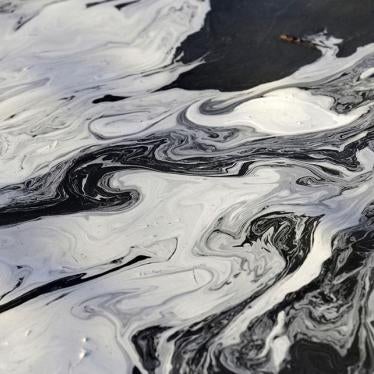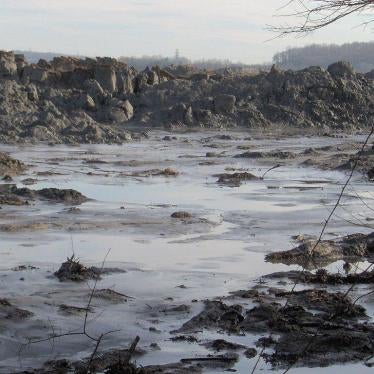Thank you for the opportunity to comment on the proposed changes to the Coal Combustion Residual Rule.
My name is Sarah Saadoun and I’m a researcher at Human Rights Watch, a non-profit independent organization that investigates and reports on human rights abuses in 90 countries around the world, including the United States.
I plan to submit a more detailed written submission, so I’d like to use this time to highlight a few points.
Every person has the right to safe water and an environment that does not harm their health. Under international human rights law, governments have an obligation to protect these rights, including by regulating business activity to prevent pollution that poses an unacceptable level of public health risk. Moreover, a necessary component of any policy framework that aims to adequately protect the right to water is that existing protections should not be removed or weakened without careful consideration and a showing that full use is being made of all available resources.
We strongly oppose the EPA’s proposed changes to the coal ash rule as a step backward that threatens the water, air, and health of people living near coal ash piles.
In fact, according to the EPA, it is proposing change to the rule regarding coal ash piles “in response to the May 2017 petitions from AES Puerto Rico LP and Utilities Solid Waste Activities Group,” an industry trade group. AES is a Virginia-based company operating a coal plant in Guayama, Puerto Rico, that is the site of a nearly half-million-ton coal ash pile. AES testing found that the coal ash is leaching arsenic, molybdenum, selenium, and lithium into the groundwater—all but arsenic at levels above what the EPA considers to be safe. Test results from the following year showed that levels of all but lithium had increased. The groundwater forms a part of an aquifer that is the sole source of drinking water for thousands of residents.
Moreover, residential areas near the plant are exposed to fugitive dust from the coal ash pile. Studies have shown air pollution from coal ash to be a significant health concern. For example, a study by two University of Louisville scientists found that children living near a coal ash landfill—which presumably has less impact than an uncontained coal ash pile—in Louisville, KY were significantly more likely to have health and behavioral problems than those in a comparison group, even after controlling for age, gender, and second-hand smoke exposure. An ongoing study of the same Louisville community found coal ash containing toxic metals in two-thirds of the 162 homes tested, all of which had children living there.
Studies conducted by public health scientists from University of Puerto Rico have documented a worrisome trend of increased incidence of cancer and other chronic diseases in Guayama in recent years.
Hurricanes Irma and Maria in 2017 were a blunt reminder that the more frequent and heavier storms due to climate change exacerbate the threat piles of toxic waste pose to public health.
In light of all this, the EPA should be redoubling its efforts to ensure AES meticulously complies with its obligation to remediate, monitor, and prevent pollution. Instead, it appears to be weakening these rules at AES’ behest.
The EPA is proposing to subject coal ash piles located on a utility site to the same rules as coal ash already delivered for beneficial reuse. But to do so would effectively mean that a half-million-ton coal ash pile, which has already been shown to be dangerously contaminating groundwater, would be subject to the same minimal environmental requirements as a small, temporary pile of coal ash awaiting reuse.
The EPA’s original justification for distinguishing between “on-site” and “off-site” coal ash piles was to address precisely situations like this one: coal ash is typically stored in greater quantities at a utility site and its presence is permanent, even if there is a constant cycle of removing and adding coal ash to the pile. Not only does the proposed change fail to address this problem, it specifically opts not to place limits on what qualifies as “temporary” coal ash storage, rather than permanent disposal. Even as AES’ efforts to sell its coal ash have faltered, and the vast majority will almost certainly remain in place, the efforts themselves may be sufficient for the utility to claim that its pile should be regulated as storage.
In other words, the proposal seems to be tailor-made to allow AES to avoid properly managing the environmental impacts of its coal ash. To allow it to do so not only endangers the health of Guayamans, but of all people living near coal ash sites. What’s to stop other utilities from taking advantage of the loophole EPA is proposing to create?
We urge the EPA to protect and maintain a strong coal ash rule that protects people’s rights to clean air, water, and health.








